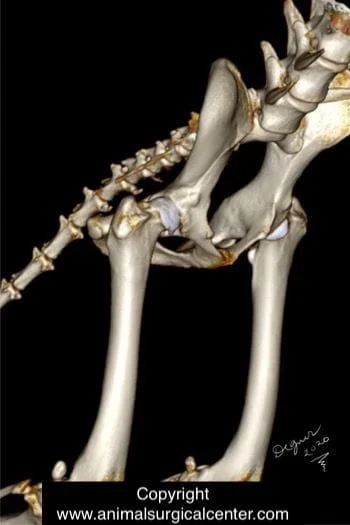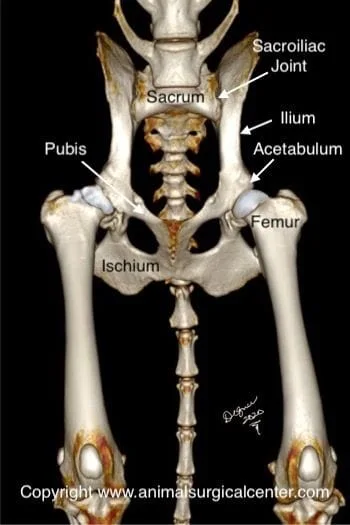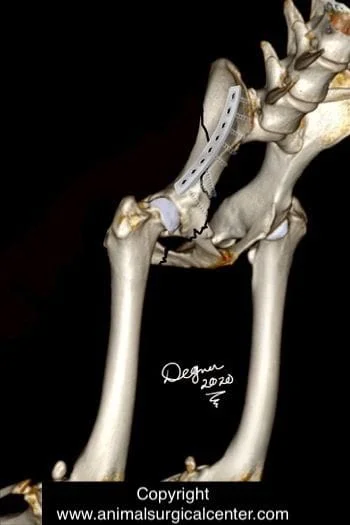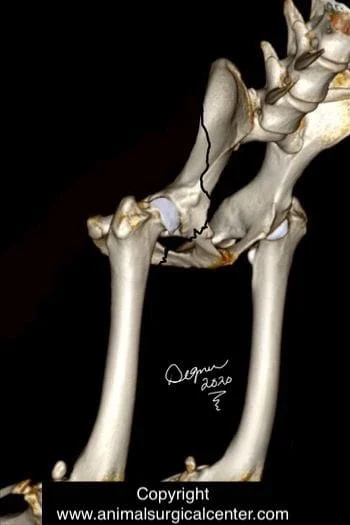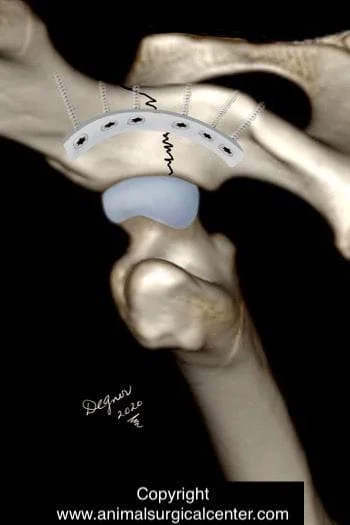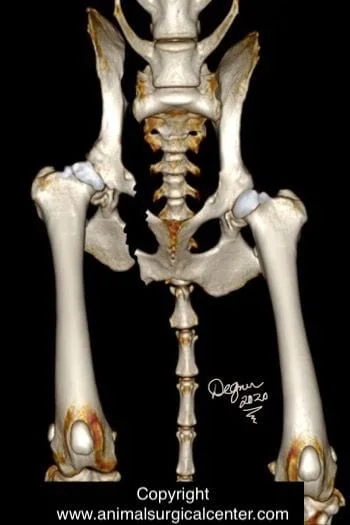Key Points
- Careful of internal organs in the abdomen and chest need to be assessed in patients that have pelvic fractures
- Evaluation of nerve function is critical in patients having pelvic fractures
- Surgical repair of pelvic fractures results in quicker return to function and less pain during the healing phase
- Prognosis is usually good following surgery
Initial visit- downloadable forms/information for clients:
History sheet - Client initial consultation history
Client education handout - pelvic fractures
Discharge instructions for postop care - dog
Discharge instructions for postop care - cat
2-week recheck visit - downloadable forms/information for clients:
History form - 2 week postop (Telemedicine evaluation) - dog and cat
Postop care instructions 2-week fracture repair recheck - cat
Postop care instructions 2-week fracture repair recheck -dog
8-week recheck visit - downloadable forms/information for clients:
History form 8-week fracture recheck (in hospital) - dog and cat
Postop care instructions 8 week fracture recheck - dog
Downloadable forms for referring veterinarians:
Anatomy
The pelvis is like a box. The front of the pelvis is attached to a portion of the spine called the sacrum by a fairly immoveable sacroiliac joint. The ilium is the front half of the pelvis and consists of a broad portion called the iliac wing and a narrowed part called the shaft of the ilium. The acetabulum forms the cup which articulates with the head of the femur bone to form the hip joint. The pubis is a narrow strut of bone that joins the acetabulum and the ischium. The ischium is a table like portion of the pelvis that has ham string muscles attached onto its back portion. Together, the pubis and ischium form the floor of the pelvic canal. The sciatic nerve, which is the primary nerve of the back leg, runs along the inner side of the ilium and over the top of the ischium just behind the acetabulum (see illustration as viewed from a dog's behind).
Surgery
Usually at least two fractures of the pelvis or a single fracture and a dislocation of the sacroiliac joint occur; rarely a single fracture is present. Fractures of the ilium and acetabulum can cause nerve injury. The sciatic nerve may also be entrapped between the bones at the level of a sacroiliac dislocation. Weight is transmitted from the hind limb into acetabulum, ilium and sacroiliac joint, then into the spine. As a result, a fracture or dislocation of any of these usually requires surgery. Fractures of the acetabulum need to be repaired as perfectly as possible in order to minimize development of arthritis of the hip joint. Fractures of the ischium and pubis usually do not require repair. Dogs that have pelvic fractures frequently also have:
- Chest trauma such as bruised lungs, ruptured lungs, rib fractures, tear of the diaphragm, bleeding into the chest
- Bleeding into the abdomen due to trauma to the liver or spleen
- Ruptured bladder
- Abdominal wall hernia (prepubic tendon rupture)
Fractures of the ilium are usually repaired using a plate and screws. If untreated, the ilium will heal in an abnormal position which collapses the pelvic canal and may compress the colon, resulting in chronic constipation.
Fractures of the acetabulum are repaired with a plate and screws or sometimes with pins, wires and bone cement. Fractures of the back 1/3 of the acetabulum can be left to heal with no surgery, but ideally all acetabular fractures should be repaired to have the best outcome. If the fracture of the hip is too extensive, femoral head and neck excision may be the best option.
Sacroiliac luxation is a separation of the ilium from the portion of the spine called the sacrum following extensive ligament damage. Invariable the pubis and ischium are also fractured. In some cases the patient will have a sacroiliac luxation on one side and an ilial fracture on the contralateral side. Occasionally, the pelvis is intact; however, both sacroiliac joints are dislocated. Sacroiliac luxation can be repaired either with a traditional open approach or with a minimally invasive surgery via intra-operative radiographic assistance. One or two screws are typically used to repair this type of dislocation, by placing a screw(s) across the ilium and into the body of the sacrum.
Aftercare
After surgery exercise must be limited until the fractures have healed. A soft bed is essential to prevent bed sores on bony prominences such as the side of the hip, ischium, side of the knee and side of the hock and paw. If your pet cannot turn him/herself, you may need help with this every 4 hours. A muzzle, which can be obtained from a pet store, should be put on your pet to prevent biting the handler during turning of the patient. When taking your pet outdoors, a sling (can use a bathroom towel, fabric grocery bag with the sides cut down, or a commercially available sling) should be used to support weight on the hind end, especially if your pet is not stable on the feet for the first few weeks, or until your pet can walk well without assistance. Throw rugs or carpeting should be used to cover slippery floors to help your pet ambulate. In some cases, the patient will be totally recumbent and will not want to get up at all. In this situation, pee pads should be used to catch urine and feces. The perineum should be monitored for urine or fecal irritation/scalding and vitamin A&E ointment can be used to protect the skin.
Potential complications
As with any surgery, anesthetic death may occur, especially if poly trauma has occurred to not only bones but internal organs. Infection, although not common, may necessitate administration of additional antibiotics. In some cases, the urethra can get trapped by bones of the pubis or ischium and surgery would be needed to decompress the urethra. Likewise the sciatic nerve could be damaged from the trauma and in some cases the nerve may take 6 to 9 months to recover function, yet in some cases the nerve never regains function, thus amputation of the limb may be needed. Nonhealing of pelvic bones is uncommon, as these bones have a good coverage with muscles, hence good blood supply, which is important for healing. If the pet is not limited in activity, screws, plates or pins may break before the bone has healed. If the bones heal with exuberant callus formation, constipation may result from pelvic canal narrowing. Should the patient be a breeding bitch, natural birthing of puppies is unlikely and C-section likely will be needed, as the pelvic canal will be somewhat narrowed after fracture healing has taken place.



